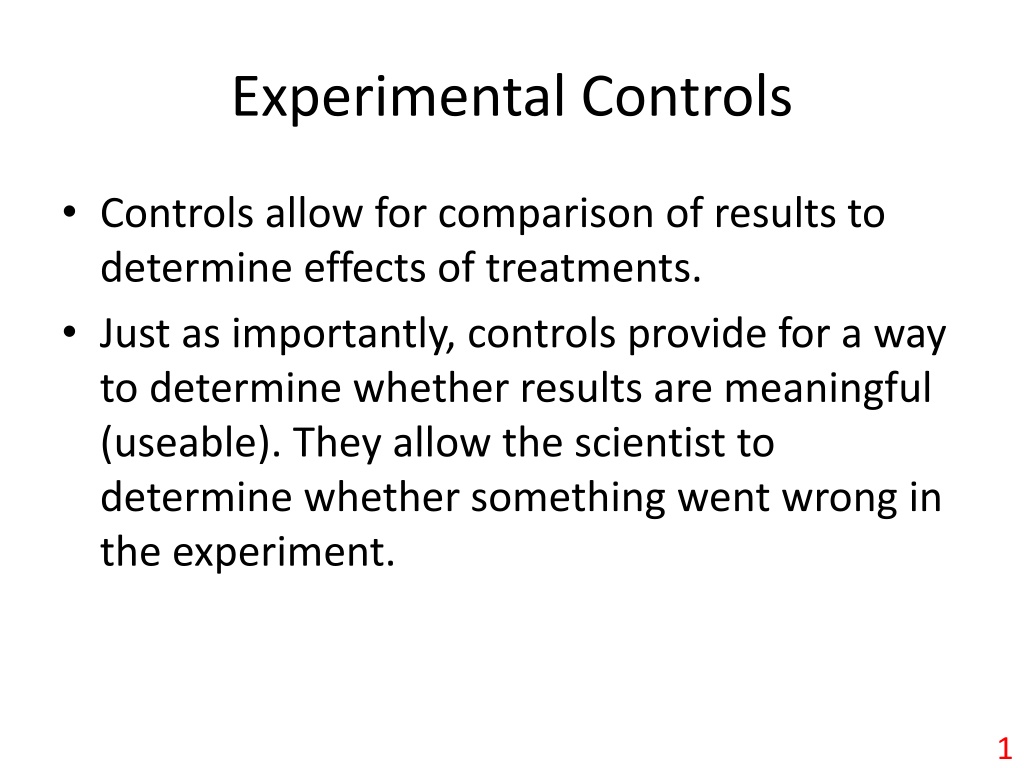
Understanding Experimental Controls for Effective Scientific Research
Experimental controls are crucial for comparing results, determining treatment effects, ensuring result usability, and identifying issues. This informative content delves into the significance of controls, their role in experiments, and how different types of controls help scientists validate and interpret their findings accurately.
Download Presentation

Please find below an Image/Link to download the presentation.
The content on the website is provided AS IS for your information and personal use only. It may not be sold, licensed, or shared on other websites without obtaining consent from the author. Download presentation by click this link. If you encounter any issues during the download, it is possible that the publisher has removed the file from their server.
E N D
Presentation Transcript
Experimental Controls Controls allow for comparison of results to determine effects of treatments. Just as importantly, controls provide for a way to determine whether results are meaningful (useable). They allow the scientist to determine whether something went wrong in the experiment. 1
Primers and Dyes One set of primers (with the red dye) is specific for DNA found in GM foods. There are two kinds of primers in the red solution: one that recognizes the CaMV 35S sequence; one that recognizes the NOS terminator. The other set of primers (with the green dye) is specific for a gene that codes for a photosystem protein, which is found in nearly all plants. 3
Primers and Dyes (cont.) The GMO primer (red) will allow PCR amplification of DNA from a GM food. It therefore provides for a positive test for GM food. The Photosystem primer (green) will allow PCR amplification of DNA from any plant. It serves as a control that tells you whether a negative result for GMO is a true negative result (the food is not GM) or a result of failure to successfully extract DNA. 4
Control for Contamination The experiment includes a sample of certified non-GMO food (the oatmeal). This serves as a control against a false positive. If the oatmeal tests positively for GMO, this indicates that the sample was contaminated with GMO DNA. Therefore, if your test food also gives a positive result, you cannot trust the result, because your food sample might have been contaminated also. 5
Control for Successful PCR The experiment uses a solution (GMO+) containing DNA from a GM food. This serves as a control against false negatives. If the GMO+ solution gives a negative result for GMO, this is an indication that the GMO DNA was not successfully amplified by PCR. Therefore, if your test food also gives a negative result, you cannot trust the result, because PCR amplification might have failed for your test food as well. 6
A Nearly Universal Test The experiment includes primers for the two DNA sequences (CaMV 35S and NOS terminator) that are currently the ones most commonly used for GM foods. Since 85% of GM foods currently being produced contain one or both of these sequences, 85% of GM foods will be detected by this experiment. Even if nothing goes wrong in the experiment, there is still a 15% chance of a false negative occurring. This would happen if the test food is a GM food that was produced without either of these two commonly used DNA sequences. 7
